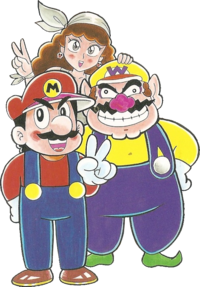Wario (franchise)
| Wario | |
|---|---|
 | |
| First installment | Wario Land: Super Mario Land 3 (1994) |
| Latest installment | WarioWare: Move It! (2023) |
| Number of installments | 24 |
| Series | Wario Land, WarioWare |
The Wario franchise is a spin-off of the Super Mario franchise that features Wario as the main character. It is the first franchise created by Nintendo to feature a villain/anti-hero as the main protagonist. The franchise was created by game designers Hiroji Kiyotake and Takehiko Hosokawa for Nintendo R&D 1, which primarily handled its games and later turned these duties over to its successor, Nintendo SPD Group No. 1. Some Wario games have been developed by other companies, including Suzak, Good-Feel, and Intelligent Systems.
The Wario franchise branches into two main series, the Wario Land series and the WarioWare series. Wario Land games are platform games that involve the greedy and selfish protagonist looking for treasure and other ways of accumulating wealth. Its first game, Wario Land: Super Mario Land 3, was the first game to feature Wario as a playable character, and is the sequel to the game in which Wario first appeared, Super Mario Land 2: 6 Golden Coins. The WarioWare games consist of microgames, very short minigames played in quick succession, which are made by Wario and his friends, motivated by his wish of making money; they work in the fictional company WarioWare, Inc., based in Diamond City. These microgames often make use of the technological innovations of the system the game is released for. Beyond these two main series, the Wario franchise has various installments in other genres.
Main character overview
- Main article: Wario
The titular Wario was created as an archrival for Nintendo's mascot Mario. He first appeared in the 1992 Game Boy title Super Mario Land 2: 6 Golden Coins, where he was the main antagonist and final boss. His name is a portmanteau of Mario's name and the Japanese word warui (
Wario is portrayed as a corrupt, hot-tempered, and exaggerated version of Mario, inverse to him in both appearance and personality. Whereas Mario is selfless in his acts and always adventures for the good of others, this is not the case with Wario. His primary trait is his greed, and he always adventures for personal, material gain; even when he does acts that would be considered "heroic," he only does them with the promise of treasure. Though he does have some of Mario's moves, such as defeating certain enemies with a single jump, Wario more often defeats enemies with his superhuman strength: barging them out of the way with his trademark body slam, stunning them with powerful ground-shaking butt stomps, and in one of his games, attacking with wrestling moves. Other powers of his include making use of various transformations to navigate certain obstacles, and his proficiency with bombs.
Creation and development
Wario was created as part of a decision to introduce a new character as the main villain of Super Mario Land 2 to meet a vision from the staff where the game was to divert from the conventional objectives of the Super Mario series; Mario in that game was to fight to win back something of his own, instead of fighting for the benefit of others, such as Princess Peach and the citizens of her Mushroom Kingdom. He was not the first character the staff came up with, however; several other characters had earlier been created and rejected. Kiyotake based Wario's relationship with Mario on the American comic strip and cartoon character Bluto, archnemesis of Popeye the Sailor, who compared to him is physically larger, more cunning, and motivated by self-interests.[1] The finalized version of Wario's design was drawn by the Super Mario franchise's foremost hand-drawn artist, Yoichi Kotabe, taking inspiration from not only Bluto but also another villain character, the circus owner Stromboli from Walt Disney's Pinocchio.[2]
Main series
| Series | ||
|---|---|---|
| Artwork | Summary | List of games |
| Wario Land | ||
| The Wario Land series of platformers started in early 1994 with the Game Boy game Wario Land: Super Mario Land 3, a sequel to Wario's debut game, Super Mario Land 2: 6 Golden Coins. Wario Land has its titular main character grubbing for money and hunting for treasure in attempts to increase his wealth; in the process, he confronts various antagonists, including the pirate Captain Syrup and her Black Sugar Gang, a gruesome creature called Demon Head, a clown named Rudy, the Golden Diva, and the Shake King. The series features drastic changes from the Super Mario Land games it is derived from, both stylistically and story-wise. Wario Land: Shake It!, in particular, is notable for incorporating anime-style introduction and ending cutscenes. |
| |
| WarioWare | ||

|
WarioWare, named Made in Wario in Japan, was established in 2003 with WarioWare, Inc.: Mega Microgame$! for Game Boy Advance. It was initially developed by Nintendo R&D1; following the first two installments, the series was co-developed by Intelligent Systems. This series' hallmark is its microgames, which are short, simple games (usually three to five seconds in length) played in quick succession. The idea for the series came from Mario Artist: Polygon Studio for the 64DD and its "Sound Bomber" mode.
The series features a story set in Diamond City, with Wario, motivated by his wish of making money, founding the company WarioWare, Inc. to create the microgames. He hires his various friends as game developers: disco dancer Jimmy T, part-time-working high school student Mona, young video game fanatic 9-Volt, taxi cabbies Dribble & Spitz, kindergartener ninja twins Kat & Ana, mad scientist Dr. Crygor, and intelligent alien Orbulon. In later installments, more characters are added to this roster, including 9-Volt's music-loving best friend 18-Volt and strict but caring mother 5-Volt, the stoic young witch Ashley and her skittish familiar Red, karaoke robot Mike, martial artist Young Cricket and his wise sensei Master Mantis, aspiring inventor and singer Penny, and boisterous self-proclaimed hero Lulu. At least one entry of the WarioWare series has been released for every Nintendo system from the sixth generation onwards, with several of its installments making heavy use of the unique technological capabilities of the console for which the game is released. For example, WarioWare: Twisted! centers around the usage of tilt controls, while WarioWare: Touched! focuses on the Nintendo DS's touchscreen. |
|
Other games
| Title | |
|---|---|
| Cover, original release, and system | Synopsis |
| Mario & Wario | |
 Super Famicom |
Mario & Wario is a side-scrolling puzzle-platformer designed by Satoshi Tajiri and developed by Game Freak for the Super Famicom console. Released in August 1993, it is one of the few Super Mario games to utilize the Super Famicom Mouse accessory. The gameplay focuses on guiding Mario, who has various objects on his head placed by Wario, through a series of levels consisting of various obstacles and traps. Because Mario has been rendered sightless and is constantly in danger of walking into hazards, the player controls the fairy Wanda, who can protect Mario by changing the environment around him as he moves towards the levels' end.
The game was initially planned to be localized for the North American market (as shown by it being previewed in the September 1993 issue of Nintendo Power and a Canadian ad for a Kellogg's contest,[3] which featured a tentative box art), but this localization ended up being canceled. |
| Wario's Woods (NES) | |
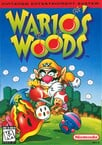 NES |
Wario's Woods is a puzzle game released in 1994. The NES version was the last officially licensed game released for the console in North America and was the only game in its library to have an official rating by the ESRB. Wario's Woods is a falling block puzzle game where the objective is to clear the playing field of monsters by using bombs, arranging them into rows of matching colors. Unlike in many puzzle games that have the player directly manipulating the game pieces, the player controls Toad, who moves around the playing field and arranges them after they have fallen. |
| Wario Blast: Featuring Bomberman! | |
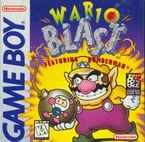 Game Boy |
Hudson Soft created the game Wario Blast: Featuring Bomberman!, a crossover between Wario's franchise and that of Hudson's flagship character Bomberman. The original release of the game was Bomberman GB, but for the Western release, Wario was added to the game. In the game, Wario has decided to loot Bomberman's world for his gain, and Bomberman must confront Wario in various battles to save his world from complete decimation. The player can play as either character; however, this does not significantly change the gameplay in any way. |
| Wario's Woods (SNES) | |
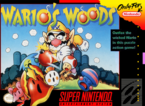 SNES |
A second version of Wario's Woods was made for the SNES. The original cartridge version was released in the West only; the game only appeared in Japan on Nintendo's Satellaview service. Compared to its NES counterpart, it features multiple settings for levels to take place in, and more significantly, a variant of the "VS Mode" where the player plays against the computer, following Toad as he engages in one-on-one matches against Wario's many minions, followed by a decisive final duel with Wario himself. |
| Wario World | |
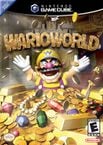 Nintendo GameCube |
Wario World is a spin-off of the Wario Land series developed by Treasure, released for the Nintendo GameCube in 2003 and 2004. It is the only 3D platformer in the Wario franchise. In the game, Wario is elated at his newly-constructed castle filled with treasures, only for one of his stolen treasures, the evil black jewel, to transform the castle into a series of worlds. With the help of the Spritelings he rescues along the way, Wario must traverse each world and defeat the black jewel in order to reclaim his castle and treasures. |
| Wario: Master of Disguise | |
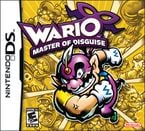 Nintendo DS |
Wario: Master of Disguise, developed by SUZAK Inc. for the Nintendo DS, has Wario advance through levels by taking advantage of seven alternate "forms" (other than his normal "Thief" form). One day, while switching through television channels, Wario's attention is caught by The Silver Zephyr, a show about a thief who can wield various disguises. He quickly creates a helmet that teleports him into the show's world, and steals Goodstyle, the disguise-changing wand of its star, who is really the powerless Count Cannoli. Wario also tracks down an ancient tablet called the Wishstone, confronts another thief called Carpaccio, and in the end, encounters and destroys the demon Terrormisu, who is sealed inside the Wishstone. After his final victory, Wario wishes for all of Count Cannoli's money and treasures; though this request is granted, the money is not teleported out of the TV world, infuriating Wario. |
Appearances in other series
Wario is a playable character in Super Smash Bros. Brawl, his default outfit being his motorcyclist attire from the WarioWare series; after obtaining a Smash Ball, he can also transform into Wario-Man, his superhero alter-ego seen in a few of that series' entries. His motorbike is used by him in one of his special attacks. A stage named WarioWare, Inc., based on the "Variety Tower" location in Mega Microgame$!, has several different microgames running in the background, which set tasks that upon their completion award the player with invincibility, growth, and other power-ups. Wario returns in Super Smash Bros. for Nintendo 3DS / Wii U and Super Smash Bros. Ultimate, where he is now an unlockable character, instead of one playable from the start. The later Super Smash Bros. games have also featured WarioWare characters as helpers, trophies, and stickers.
Wario makes a guest appearance in the eighth level of Densetsu no Starfy 3, where Starfy must induce his various transformations from Wario Land 4 to progress throughout the stage.
The WarioWare series has strong ties to the Rhythm Heaven series (developed by the same team). Initially limited to quick references such as featuring the Alien Bunnies cameo in a few stages, the series 3DS installment Rhythm Heaven Megamix features two unlockable challenge sets starring the cast of the WarioWare series. In turn, Game & Wario and WarioWare Gold feature multiple cameos by Rhythm Heaven characters, with the latter game also including an extra calling back to the events of Rhythm Heaven Megamix.
The WarioWare series has also occasionally crossed over with the Daigasso! Band Brothers series: all three installments feature Ashley's Theme either built-in or as an official downloadable track and Nintendo would publish a short strip on its Japanese kids' website, dealing with Barbara's attempt to profit from Ashley's singing talents. In October and November 2018, the company ran a cross-promotional contest between WarioWare Gold and Band Brothers P asking contestants to rearrange a selection of songs from the WarioWare series in Band Brothers P's music editor, with the winning entries being judged by the WarioWare team and made officially downloadable in Band Brothers P.[4]
Other media
Anime
A highly obscure 1993 educational VHS release, the Mario Kirby Meisaku Video (meisaku meaning masterpiece), featured a story loosely based on Mario vs. Wario (with the second half of the tape starring fellow Nintendo icon Kirby) told via still imagery and narration accompanied by text that was intended to teach Japanese children kanji, Chinese characters which are commonly used in Japanese writing.
Literature
Wario has been featured in several Super Mario-related mangas with Kodansha's Super Mario manga and Super Mario-kun featuring loose adaptations of the first Wario Land and Wario's Woods. In addition, Super Mario-Kun's author would write a short-lived spin-off titled Ore Dayo! Wario Dayo!!, whose four issues successively adapted the plot of Wario World, Wario: Master of Disguise and Wario Land: Shake It!.
Nintendo Power published a ten-page story based on Super Mario Land 2: 6 Golden Coins titled Mario vs. Wario (unrelated to the game of the same name), which was featured in the January 1993 issue. The story was later reprinted as bonus content for the graphic novel format release of Super Mario Adventures. Mario vs. Wario: The Birthday Bash, a second Mario vs. Wario comic, was published a year later, in the January 1994 issue.
A choose-your-own-adventure book based on Wario Land 4 was released by Scholastic in 2002 as the last installment of its short-lived Game Boy Advance series.
Several Wario mangas have been published as part of various Japanese video game magazines; the longest-running of these, GO Ketsu Wario, was published in Dengeki Nintendo DS from 2007 to 2011 and was a gag strip initially featuring the cast of Wario: Master of Disguise before being retooled to focus on Wario Land: Shake It!. A one-off manga based on WarioWare: Touched! simply titled Made in Wario was published as an extra in the March 2005 issue of Comic Bom Bom. Another short gag-striped based on Touched!, Waiwai! Wario, was published in the February 2006 issue of Famitsu DS+Wii and dealt with Mona's attempt to get Wario to keep his promise to take her to her concert. Wario also guest stars in Wario to Saikyō Tag da Fii!, a chapter of the manga adaptation of The Legendary Starfy based on his appearance in Densetsu no Starfy 3.
References
- ^ Super Mario Land 2: 6 Golden Coins official Shogakukan game guide. Shmuplations. Page 106-111. Retrieved June 3, 2024.
- ^ William Andureau (December 6, 2018). Les confidences du dessinateur historique des personnages Nintendo. Le Monde (French). Retrieved June 3, 2024.
- ^ Mario & Wario. SNES Centra. Retrieved June 3, 2024.
- ^ October 31, 2018. バーバラ様とワリオ社長からトリック・オア・トリート? 『バンブラP』と『メイド イン ワリオ ゴージャス』とのコラボイベントを問答無用で決定!?. Nintendo (Japanese). Retrieved June 3, 2024.

